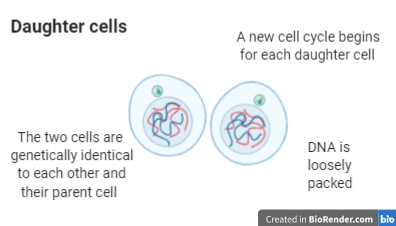Mitosis is a type of cell division that results in two daughter cells that are identical to each other and their parent cell as well. Mitosis is an important process for many organisms since it serves different purposes. The zygote, the first cell of a new organism, undergoes a series of mitotic divisions to give rise to an embryo that consists of a large number of cells depending on the species. In addition to development, mitosis takes place during growth by creating new cells. When there are injuries or worn-out cells, mitosis occurs again to form new cells for replacement. Mitosis is also a form of reproduction for single-celled organisms as it creates new individuals.
Preparation for division
During the S phase of the cell cycle, the cell replicates its entire DNA, getting ready to split in two and give identical copies of its DNA to each new cell. However, the mitotic division is not simple. It consists of a series of steps that need to be carried out with caution in a specific order, to ensure that no mistakes that would put the organism in danger take place. From the initiation of the mitotic phase until the separation of the daughter cells, changes are made concerning the structure of the nucleus, cytoplasm, chromosomes, and cytoskeleton, as we will see in the following paragraphs.
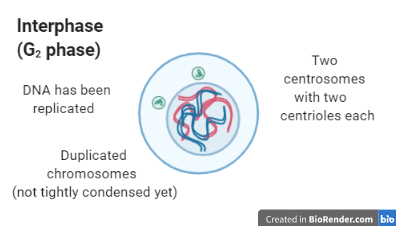
Mitotic phases
A mitotic division is divided into four phases, each of whom is responsible for various changes inside the cell. These are prophase, metaphase, anaphase, and telophase.
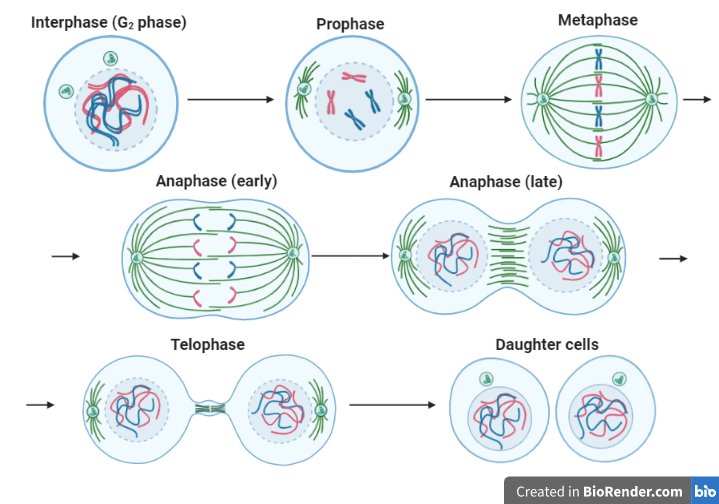
Prophase
During the early prophase, DNA is duplicated but not yet condensed in the form of metaphase chromosomes, and therefore, the process of packaging continues. Each chromosome comprises of two identical sister chromatids that are linked to the centromere. One region of the centromere is called the kinetochore. Motor proteins and microtubules bind there for the movement of chromosomes during division. These microtubules are parts of a crucial structure for the progress of mitosis, the mitotic spindle. Before we go on with the rest of the steps, let’s look at the formation of this spindle.
Centrosomes and mitotic spindle
Centrosomes are cytoplasmic structures. They are otherwise known as microtubule-organizing centers (MTOCs) because this is one of the places in the cell where microtubules are organized. Microtubules are long polymers consisting of monomers of a protein called tubulin. They are, among others, important parts of the cytoskeleton. At the beginning of the cell cycle, cells consist of one centrosome that contains two centrioles. The centrosome is located close to the nucleus, and during the S phase, it makes a copy of itself. The mitotic spindle formation will begin from the two centrosomes in prophase. As the microtubules are elongated, the centrosomes tend to move in opposite directions so that they end up on opposite poles of the cell. Three different groups of microtubules emerge from centrosomes and form the mitotic spindle:
- Kinetochore microtubules that bind to the kinetochore of the chromosome centromeres,
- Polar microtubules that extend from each pole to the middle of the cell. These interact with the respective microtubules of the opposite pole. They don’t bind to chromosomes, but their interaction helps in the elongation of the cell, and
- Aster microtubules that are short and extend from each centrosome to the edge of the cell and form a structure that resembles a star called aster.
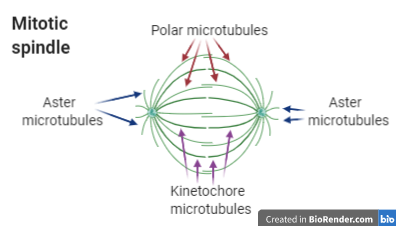
Prophase and prometaphase
Going back to the events that occur in prophase, another step is the destruction of the nuclear envelope. The nucleus does not exist anymore. Therefore, the chromosomes are scattered in the cytoplasm, where they interact with the kinetochore microtubules. After this step, we reach the late prophase, which by some biologists is considered a distinct phase, called prometaphase. With the completion of the spindle formation, the chromosomes move to the center of the cell by binding to microtubules. In each chromosome, one sister chromatid binds via its kinetochore to a kinetochore microtubule, which extends from one pole. The other sister chromatid binds to a kinetochore microtubule that emerges from the opposite pole. In this phase, the chromosomes are not immobilized on the cell’s center, yet.
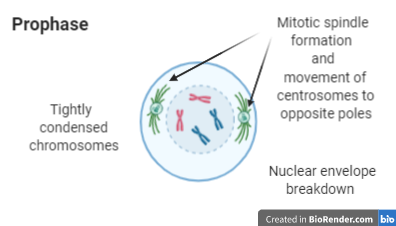
Metaphase
As metaphase begins, the chromosomes are aligned at the cell’s equator. This region is known as the metaphase plate, although it is just a term and not a physical structure. Now the chromosomes are stabilized, one next to the other. With the assistance of the kinetochore microtubules, one sister chromatid faces one pole, and the other the opposite pole. The polar microtubules contribute by stabilizing the spindle. If at this stage, the cell detects a misaligned chromosome, it halts the division to fix the problem and starts the cell cycle again.
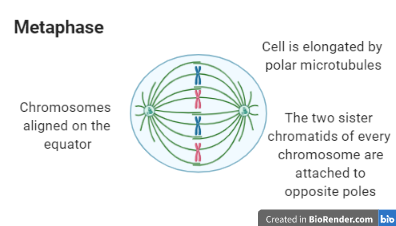
Anaphase
During anaphase, the sister chromatids are separated from each other and move in opposite directions. Microtubules shorten by depolymerization of the tubulin subunits. Therefore, they pull the sister chromatids on opposite poles, far from the equator. Polar microtubules elongate the cell to push the opposite poles apart.
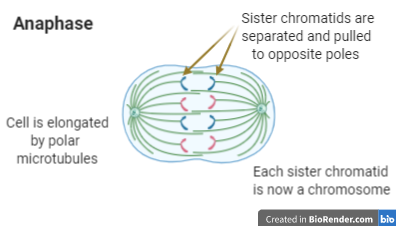
Telophase
In telophase, half of the sister chromatids are concentrated in one pole of the cell, and the other half in the other. A new nuclear envelope will form around each set of chromatids. The sister chromatids are now considered chromosomes, and they will become uncondensed to acquire the structure of chromatin that is found in interphase. The mitotic spindle is broken down, and the only step that remains is the separation of the cell in two.
Cytokinesis
Cytokinesis is a process that results in the division of the cytoplasm. This way, each daughter cell will acquire a nucleus and around half of the cytoplasm along with its organelles. Cytokinesis occurs at the same time as mitosis and often starts at anaphase or telophase. Actin and myosin filaments form a contractile ring at the cell’s equator. This ring shrinks and creates a cleavage furrow. As this process continues, the pinching eventually splits the cytoplasm in two, separating the cells. In the case of plant cells, the process of cytokinesis is different due to the presence of the cell wall. A cell plate is formed in the middle of the cell, splitting the cytoplasm, and then a new cell wall is created around the two daughter cells.
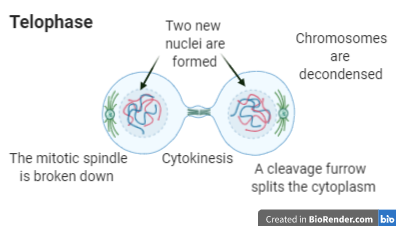
Daughter cells
After the cell division ends, two new cells are present in the place of the parent cell. They are genetically identical, containing a complete set of chromosomes, and they are ready to enter their new cell cycle. Since interphase is the first stage, their DNA appears uncondensed. Depending on the type of cell they are about to become, they will either undergo mitosis at some point or will continue undivided for the rest of their lives.
